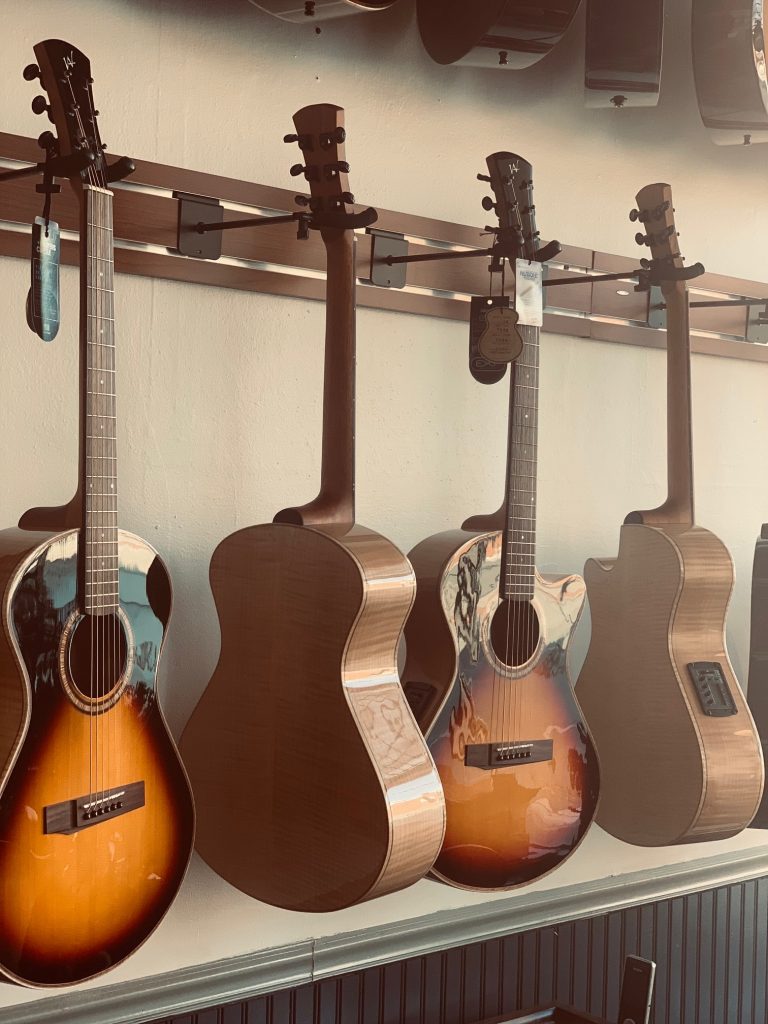[vc_row][vc_column][vc_single_image image=”1658″ img_size=”full”][vc_column_text]Andrew White was a new name to us when a very enthusiastic Ben Montague from London’s The North American Guitar got in touch a few months back. The people of TNAG were mightily enthused about the West Virginia guitar maker, and even better news was that there was an all-new, value-for-money offering in the pipeline.
“I think there are a lot of people who want something different from the usual dreadnoughts, OMs, 000s and so on,” Montague reasons. “We all love those guitars, but if you do want something different, it’s not that easy to find well under £1,000.” We concur. Thus, White’s new models are called the ‘Production Series’.
Build
 There are three body sizes in the Production Series; Cybele (the smallest, not on review), Eos (middle-size, on review here) and Freja (you guessed it, the largest – reviewed elsewhere). They all share White’s contemporary styling, with unique outlines and relatively tight waists.
There are three body sizes in the Production Series; Cybele (the smallest, not on review), Eos (middle-size, on review here) and Freja (you guessed it, the largest – reviewed elsewhere). They all share White’s contemporary styling, with unique outlines and relatively tight waists.
“Judged on its spec, build and finish alone in the context of the current market, this guitar could easily cost twice as much”
When asked about their design, White explains he finds it hard to compare them to the well-known shapes, in fact his three designs overlap the spaces between the four dominant styles in the current market: Cybele straddles parlour and 000; Eos lies between 000 and dreadnought; and Freja between dreadnought and jumbo. While it’s not the whole story, it helps to locate the start line.
 White has worked with a new facility in Korea to bring his guitars to this attainable price point, and for £699 you’d have to say the specs impress. Our instrument has a scalloped X-braced solid Sitka spruce top over solid rosewood back and sides. With its honey-tinted gloss finish, you might wonder from afar if the top is cedar: it’s definitely spruce.
White has worked with a new facility in Korea to bring his guitars to this attainable price point, and for £699 you’d have to say the specs impress. Our instrument has a scalloped X-braced solid Sitka spruce top over solid rosewood back and sides. With its honey-tinted gloss finish, you might wonder from afar if the top is cedar: it’s definitely spruce.
The aesthetic is all about modern, understated cool, though the lovely looking maple binding to the front and back of the body, wooden purfling and soundhole rosette make it far from an austerity instrument. For variety, White has chosen pau ferro (also known as morado or Bolivian rosewood, but it comes from Brazil, too) for the fingerboard and the slightly asymmetrical pinned bridge.
Because true mahogany is in such high demand/limited supply, he’s gone with Spanish cedar for the dovetail jointed neck – Martin uses it along with mahogany on many guitars, and has been doing so for many years.
Unusually at this price point, the main meat of the satin-finished neck and the headstock is one piece of wood with a tidy and simple volute adding mass and strength at the weakest point. The heel is blocked, using just one extra piece of wood and while it’s almost imperceptible until you look closely under good light, the fingerboard is also bound with pau ferro.
While it doesn’t display the kind of ultra-fastidious finishing of certain £2,000-plus brands, judged on its spec, build and finish alone in the context of the current market, this guitar could easily cost twice as much.
Sounds
The guitar’s string spacing measures 35.3mm over a 43.2mm nut. These things are about personal preference, but that spacing, particularly, will feel tight for those who like to play fingerstyle.
“The Eos doesn’t immediately strike you as a small-body guitar… and that’s because it isn’t!”
Likewise, 55.5mm isn’t expansive at the saddle, but it’s no different from many modern guitars. The benefit is comfortable first-position chording, made all the more inviting by the slim (around 21.4mm deep at the first fret), easy-playing satin-finished C-profile neck. It’d be even more so with some extra fingerboard-edge rolling – perhaps a bit much to expect at £699!
In any case, if you’re not a long-time/dedicated acoustic player, making the jump from your electric to this guitar won’t be a struggle when it comes to the neck dimensions and profiles, or indeed the scale length: 648mm is the same as a Fender Stratocaster or Telecaster. More experienced acoustic players may well want more meat in the neck and wider string spacing: it’s a matter of personal preference.
The Eos doesn’t immediately strike you as a small-body guitar… and that’s because it isn’t! The looks are deceptive; the lower bout is 15.75 inches across, which is as wide as many dreadnoughts, but the tone is markedly different.
There’s notably more midrange prominence, that makes it a promising fingerpicker, either for more contemporary, altered-tuning stuff or older-voiced bluesy and folky styles, albeit with a stronger bottom-end support than you’d expect from many 000-type designs.
Those who played the Eos in the office kept using the term ‘woody’ as a point of difference from the often tight, superficial tones of many mid-priced, identikit acoustics: ‘not generic’, you might say. Its strident projection isn’t a million miles away from Taylor’s 214, though the Eos has more complexity: they’re two guitars you should definitely A/B demo.
The Eos will be popular with folk and blues-inspired players looking for a projecting guitar. £699 is exceptional value for a solid rosewood and spruce guitar, not to mention the high-quality construction and contemporary design.
Original Article:
http://www.musicradar.com/reviews/guitars/andrew-white-eos-1010-616649
[/vc_column_text][/vc_column][/vc_row]








